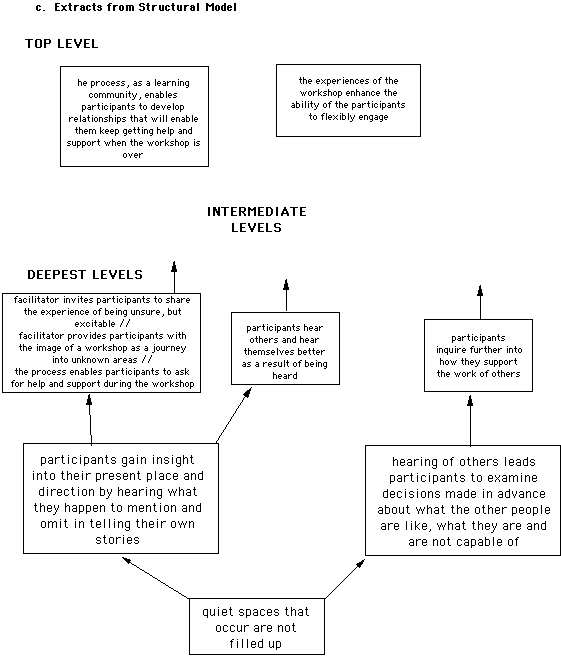During the spring and summer of 2000 I participated in four innovative, interdisciplinary workshops. A review of the workshops led me to dig deeper into how workshops work when they do. I assembled a list of heuristics that I include below. A member of the audience for my first presentation of this review, Tom Flanagan, offered to help me develop a more systematic set of principles for bringing about successful workshops. The process he led me through involved:
a. Defining my criteria for a successful workshop;
b. Rephrasing the heuristics as conditions that might contribute directly or indirectly to these criteria being fulfilled;
c. Answering a set of questions of the form: “Would addressing condition A significantly help in achieving condition B?”
These questions were generated by software that analyzed my responses and then arranged the conditions from “deep” to “top,” where deeper conditions are helpful for the ones above them. This constitutes the structural model.
Tom’s intention was only to introduce me to the concept, not to lead me systematically through the full process so I do not want to overinterpret the outcome. I include below only the deepest three layers and the top of the model to help readers picture a structural model. Let me simply draw attention to the deepest condition, “quiet spaces that occur are not filled up.” It is no small challenge for someone organizing or facilitating a workshop or organized multi-person collaborative process (OMPCP) to ensure that this condition is met. Conversely, if it is not met, it should not be surprising that the criteria for a successful workshop are not achieved. In the same spirit, given that I am interested in stimulating further inquiry about OMPCPs and, more generally, about the relationship between knowledge and inquiry — between product and process — I will say no more at this point.
Conditions for a Successful workshop
a. Criteria of success
i) the outcome is larger and more durable than what any one participant came in with. Durable means
- a) the participants are engaged in carrying out or carrying on the knowledge and plans they develop; and
b) the knowledge is applied and has significance; and
ii) participants’ subsequent work enhances the capacity of others to flexibly engage, that is, to connect with people who are able to take initiative-or are almost able to-in forming communities of practice/change collaborations that provide their participants experiences that enhance their ability to flexibly engage.
b. Conditions that might contribute directly or indirectly to these criteria being fulfilled
- it brings to the surface knowledge of the participants that they were not able, at first, to acknowledge.
- participants get to know more about each others’ not-yet-stable aspects.
- quiet spaces that occur are not filled up.
- participants recognize that there is insight in every response.
- the facilitator invites participants to share the experience of being unsure, but excitable.
- the facilitator provides participants with the image of a workshop as a journey into unknown areas or allowing them to see familiar areas in a fresh light. (A workshop/journey involves risk; requires support; creates more experiences than can be integrated at first sight; yields personal changes.)
- participants gain insight into their present place and direction by hearing what they happen to mention and omit in telling their own stories.
- participants are heard.
- participants hear others and hear themselves better as a result of being heard.
- this hearing of others leads participants to examine decisions made in advance about what the other people are like, what they are and are not capable of.
- participants inquire further on the issues that arise in their own projects.
- participants inquire further into how they support the work of others.
- participants’ energies are mobilized by the process.
- there is a wide range of participants, not only technically expert participants.
- the plans allow for individual participants to select and focus on a subset of the workshop-generated specific plans or knowlege in their subsequent work.
- the process, as a learning community, enables participants to ask for help and support during the workshop.
- the process, as a learning community, enables participants to develop relationships that will enable them keep getting help and support when the workshop is over.
- participants find opportunities to affirm what is working well.
- the reflection on each phase leads to one concrete product to take into next phase.
- the experiences of the workshop enhance the ability of the participants to flexibly engage.

Adapted from http://www.faculty.umb.edu/pjt/ECOS.html#appendix

March 19, 2025 at 10:56 pm
Generally I don’t learn article oon blogs, howesver I would lime to sayy that this write-up verty comppelled me to ttry annd do so!
Your writing tadte hhas ben surpeised me. Thanks, quite grdeat
article.
My blog; portxvideos.com